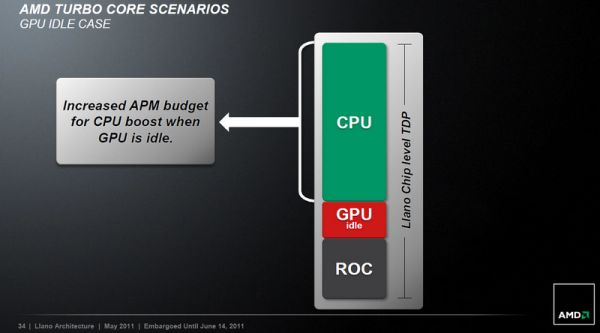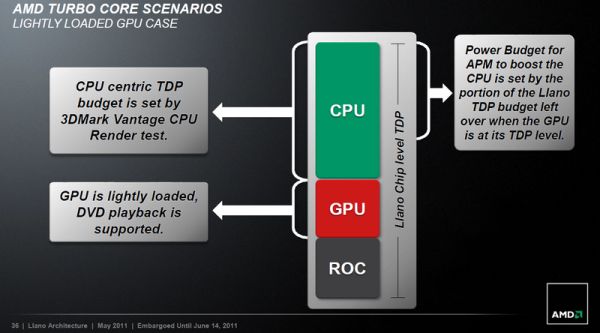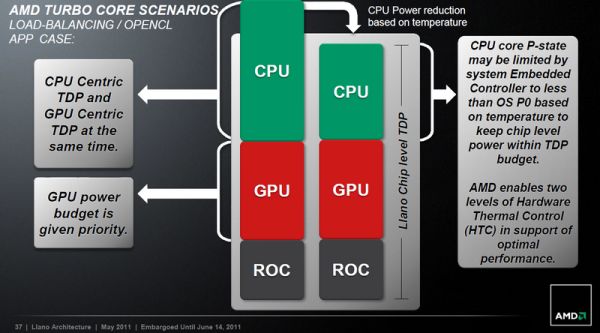ASRock A75 Extreme6 Review and Desktop Llano Overclocking
by Ian Cutress on June 30, 2011 12:05 AM ESTOverclocking on the Llano platform, by any stretch of the imagination by using this A75 Extreme6, would take ages to get a hold of and become a master. There are three main areas to overclock - the CPU, the iGPU, and the memory. But the Llano chip design is such that the CPU will only ever have a maximum TDP. If you increase the CPU and fix it at a new higher value, the maximum GPU will decrease to level the change out. Thus, if you're on a GPU limited situation (such as a modern game), then your overall frame rate will decrease. To put it another way, here's a few slides from AMD:
Slide 1: Firstly, on turbo capable APUs, when the GPU is idle the CPU can boost itself until the max level of TDP is reached. This is fairly straight forward.
Slide 2: In GPU heavy cases, the GPU power budget grows and the CPU decreases in response. This could cause several problems - if the GPU wants more power but the CPU is the bottleneck, there's not much you can do. Or of the GPU power is fixed at a high level, the CPU cannot respond by increasing its own power to increase throughput.
Slide 3: With a mild GPU usage, the CPU/GPU power sharing is levelled out, hopefully in the right order.
Slide 4: Now, here's where it gets tricky - a situation demands CPU and GPU power, but moreso GPU - it gets all the priority but the system understands that the CPU needs some too. So the system will reduce the CPU based on both temperature and total TDP.
In the terms of an overclocked system, either the CPU or GPU power requirements will no longer become mobile, effectively limiting the growth of the other - the net result is that if you have an overclocked CPU, your GPU will suffer, and vice versa.
Despite this, I gave the ASRock board a shot of adrenaline and went on a settings test. Sticking strictly to the BIOS, we can either overclock in 'Manual Mode', 'CPU OC Mode' or 'DRAM OC Mode'.
CPU OC Mode
The options are fairly straight forward for the automatic CPU OC options - from 3200 MHz to 3600 MHz in 100 MHz increments.
- At 3200 MHz, the system applies a 111 MHz bus speed, 1.4125 V on the CPU voltage, and 1.150 V on the GFX.
- At 3500 MHz, the system applies a 120 MHz bus speed, 1.4500 V on the CPU voltage, and 1.225 V on the GFX. In reality, 29x120 is ~3480 MHz, and this setting gave a load voltage of 1.512V (from the AXTU software).
- At 3600 MHz, rather than just raising the bus speed, the system drops the multiplier to 26x and applies a 138 MHz bus, with 1.4875 CPU voltage and 1.250V on the GFX. Unfortunately, this failed to boot at all.
At the 3500 MHz setting, we got these values on the benchmarks:
3D Movement, Single Thread: 88.42 (+18%)
3D Movement, Multithread: 297.29 (+18%)
Metro2033: 24.5 FPS (-18%)
OCCT maximum temperature: 51ºC
Thus confirming we get a lower gaming result at a higher CPU speed.
DRAM OC Mode
Due to the memory compatibility issues I mentioned earlier, I pulled out a pair of 4GB Patriot Memory sticks for these tests, from their Viper Xtreme range, rated at DDR3-2133 9-11-9.
In the BIOS, I had an option for DDR3-2000, DDR3-2200 and DDR3-2500. The following resulted from each of these selections:
- At DDR3-2000, a 107 MHz bus speed was applied (29x 107 = 3132 MHz on CPU), with 9-13-13 latencies.
- At DDR3-2200, a 118 MHz bus speed was applied (29x 118 = 3418 Mhz on CPU), also with 9-13-13 latencies. This setting passed all the tests.
- At DDR3-2000, a 134 MHz bus speed was applied, at the 26x multiplier (26x 134 = 3482 Mhz, suggesting that 3.5 MHz is a 'ceiling' in this case), also at 9-13-13 latencies. This setting failed Metro2033.
At the DDR3-2200 setting, we got these values on the benchmarks:
3D Movement, Single Thread: 87.42 (+17%, from CPU OC)
3D Movement, Multithread: 297.29 (+12%, from CPU OC)
Metro2033: 37.6 FPS (+26%)
So despite the CPU OC setting at 3500 MHz decreasing the Metro result by 18%, increasing the RAM to match gives an overall increase of 26% in frame rates. This is highly indicative of what we see in the land of discrete GPUs - they are very, very hungry for memory bandwidth. On a discrete GPU, we see bandwidths in the hundreds of GB/s between the processing units and the memory. We don't see those values between RAM and a CPU, so increasing that bandwidth to feed the GPU makes a significant jump in performance. Anand should have more about this in his article.
Dynamic Overclocking
This ASRock board also has another feature - Dynamic overclocking. The CPU will apply an overclock only when the computer is in use, and revert back to the set BIOS clocks when idle (keep in mind that AMD normally scales between idle and full via multipliers; the HT bus speed never changes). This feature on the ASRock board gives options from 4% to 20%, but can also be combined with an APU frequency overclock above 100 MHz.
I tried this feature in two scenarios - a 100 MHz bus with a 20% dynamic setting, and 110 MHz with a 4% dynamic setting. Both of these worked, giving me 120 MHz and 114 MHz respectively.
GFX Overclocking
The BIOS gives a option to increase the GFX core speed as well, from 654 MHz to 1800 Mhz in oddly sized jumps. I left the voltage at auto, and increased this value from 800 MHz to 1440 MHz, testing Metro 2033 each time. Unfortunately, I didn't see any improvement over stock. I don't know why this is, and as AXTU or any other GPU utility cannot currently report the actual clock rate of the iGPU for now, I'm not sure what is going on.
Manual Overclocking
Time for some real fun. Given what had gone previously with the auto overclocking, I went straight in at 1.5 V on the CPU, and a 120 MHz overclock. This worked fine, so I steadily increased the frequency until the system was not stable after multi-threaded benchmarks and runs of Metro2033. At this voltage, 130 MHz was a good ceiling to reach (29x 130 = 3770 MHz).














44 Comments
View All Comments
jjj - Thursday, June 30, 2011 - link
no desktop Llano review or there will be one soon?ganeshts - Thursday, June 30, 2011 - link
Coming soon.. We are working on it right now, getting pictures in the engine.FragKrag - Thursday, June 30, 2011 - link
On your conclusion you compared a relatively high end $150 board with budget H67 boards when earlier on in your article you said that the lower end A75 boards would cost around $100.Wouldn't it make more sense to compare a high end A75 board to a higher end H67/Z68 board and a lower end A75 board with the lower end H67? If you did it that way, you would be paying only $25-40 more for Llano over Sandy Bridge.
I do realize you haven't tested one of the $100 A75 boards, but your conclusion seems to be a bit questionable nonetheless.
L. - Thursday, June 30, 2011 - link
Motherboards are going to be much cheaper on the AMD side, as usual.Comparing mobo prices now, and taking a high-end cheap-brand on one side against a cheap board on the other does indeed not make sense.
If it's any indication, my NAS mobo (gigabyte am3) cost like 35 euros. Quite likely that there will be Llano boards around 50 euros before long.
cknobman - Thursday, June 30, 2011 - link
Agreed this article's conclusion is not based off an apples to apples comparison and is really misleading.To the reviewer - please do a better job of trying to compare similar products next time.
qu3ry - Thursday, June 30, 2011 - link
Agreed, and also:"Desktop Llano certainly isn't a low power system - the A8-3850 is rated at 100W, so if you want something to word process, look at emails and play flash games, an AMD Fusion board for $150 will do all that quite easily for all under 60W. "
Alternative: Wait for A8-3800 instead; same IGP but slower clocks (while still faster than say an E-350) @ 65 watts TDP.
Xbitlabs managed to get their hands on A8-3800 silicon which might also be worth reading (no idea what the sites reputation is like so take it with a grain of salt)
http://www.xbitlabs.com/articles/cpu/print/amd-a8-...
ganteng3005 - Thursday, June 30, 2011 - link
What about having a Core i3 2100 + H61 motherboard + Dedicated Radeon HD 6570?It runs faster on both processor and graphics, and the price is equal to the Llano combo.
Other than that --
I love the conclusion part of this article. The cheapest available FM1 A75 motherboard at google shop is currently $103 (if that is true). With the A8-3850, that will end up at $250.
Is Llano a good choice to pick over the i3 2100 for an $25 premium?
Well, it all depends on the user. And the points I would like to make are:
-If you only play flash games, browse the web, type, watch Full HD movies, and use the computer for productivity reasons, pick the Core i3 2100 - the Intel HD graphics will suffice for those flash games - with similar or even better power consumption.
-If you want to do some gaming, then A8-3850 might be the better choice.
Overall, I agree with Anand. I would personally choose the i3 2100 due to its beastial dual-core performance and being able to do anything except heavy GPU stuff - which can be solved by adding a single HD 6570 - and it runs faster than the APU, with the price being similar to the Llano.
TBH, i3 2100 and H61 without any additional GPU will run fine for office desktops. Except if the employees are allowed to play Metro 2033 in office.
AnandThenMan - Thursday, June 30, 2011 - link
What a load of PR rubbish.Exodite - Thursday, June 30, 2011 - link
How so?For mainstream users, which Llano is presumably aimed at, the i3 2100 ends up the better deal as it'll offer better performance in all common tasks.
Llano does have a better native graphics solution, though still not good enough to actually allow for gaming. And if you skip gaming both Llano and the i3 2100 are good enough to handle all other graphics tasks like video and 2D acceleration.
It makes sense to me.
L. - Thursday, June 30, 2011 - link
Stop this please.THERE IS NO SUCH THING AS A COMMON TASK THAT REQUIRES AN i3 2100 !!!
Why do you people keep on throwing that idea around, when it's clear that any basic user (you know, e-mail,facebook,youtube @ home, same @ work + excel, word, stuff) DOES NOT need an i3 (or a Llano for that matter) at all.
Llano has a much much much better graphics solution, which is completely hidden in this biased review as the gpu benchmarks w/ decent RAM are NOT SHOWN (and yes, 2ghz ram is CHEAP today, so anyone buying a Llano should not go for anything lower).
Llano does actually Allow for gaming, the titles tested here only show how with an integrated gpu, you'll be very limited in DEMANDING titles, as Crysis, Metro, ... while NOT demanding titles, like dirt 2 and pretty much everything else, will be fine without _ANY_DEDICATED_GPU_
This will of course not be at maximum settings, but come on, people play on CONSOLES every day, hasn't killed them yet.
I demand a real benchmark, with decent RAMsticks !